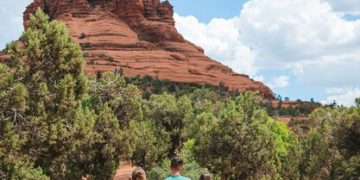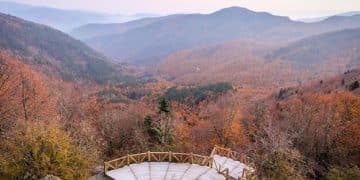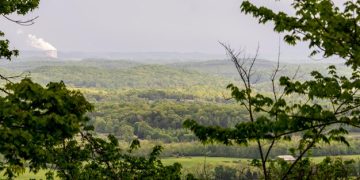Plan Your Perfect National Park Road Trip: Expert Itinerary Tips
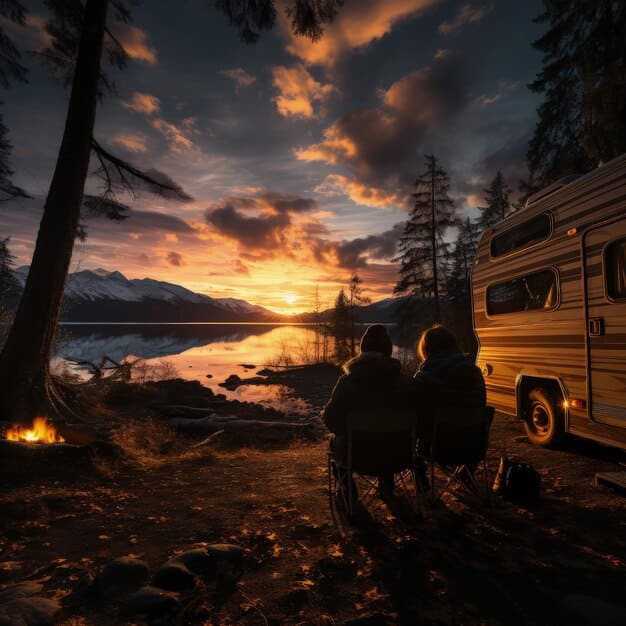
Planning a National Park road trip involves carefully selecting destinations, mapping routes, and preparing for varied landscapes to ensure a memorable cross-country adventure.
Embarking on a National Park road trip: Planning the perfect itinerary for a cross-country adventure requires thoughtful preparation and an adventurous spirit. Whether you’re a seasoned road tripper or a first-timer, mapping out your journey through America’s stunning landscapes is an unforgettable experience.
Crafting Your National Park Road Trip Vision
Before diving into maps and mileage, defining your road trip’s vision is key. This involves considering what you want to experience and who will be joining you on this adventure.
Defining Your Interests and Focus
Start by asking yourself what aspects of National Parks intrigue you most. Are you drawn to hiking, wildlife viewing, historical sites, or simply soaking in the scenery? This will help narrow down your destination choices.
Travel Style and Preferences
Consider your travel style. Do you prefer a fast-paced trip hitting many parks briefly, or a more relaxed itinerary allowing for deeper exploration of fewer locations? Your preferred accommodation style – camping, hotels, or RV parks – will also influence your planning.
- Active Adventure: Focus on parks with extensive hiking trails and outdoor activities.
- Relaxing Exploration: Choose parks known for scenic drives and accessible viewpoints.
- Historical Immersion: Include parks with significant historical or cultural importance.
Understanding these factors upfront ensures a trip that aligns with your personal tastes and available time.
By defining your interests and preferences, you’ll set the stage for an extraordinary National Park road trip: Planning the perfect itinerary for a cross-country adventure, tailored just for you.
Choosing the Right Route and Destinations
Selecting the ideal route and destinations is crucial for an unforgettable National Park road trip. With so many incredible parks to choose from, consider factors like proximity, accessibility, and seasonal conditions.
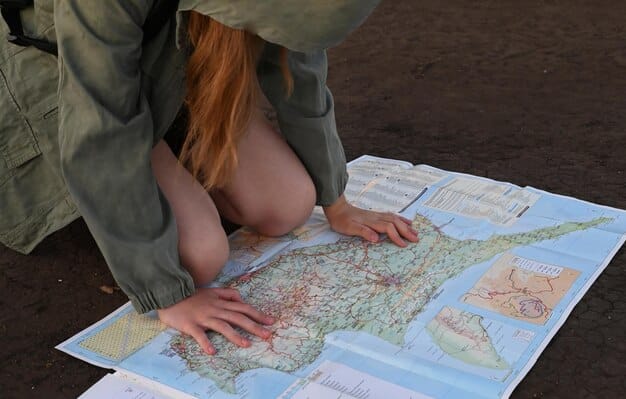
Popular National Park Road Trip Circuits
Several established road trip circuits offer diverse experiences. The Southwest Circuit highlights parks like Grand Canyon, Zion, and Bryce Canyon, while the Pacific Coast Highway offers stunning coastal views and redwood forests.
Considering Seasonal Factors
Be mindful of seasonal closures and weather conditions. Many high-elevation parks are inaccessible during winter months. Summer can bring extreme heat to desert regions. Spring and fall often offer the most pleasant temperatures for hiking and outdoor activities.
- Spring (April-May): Wildflowers in bloom, moderate temperatures in many regions.
- Summer (June-August): Peak season, but can be crowded and hot in some areas.
- Fall (September-October): Beautiful foliage, cooler temperatures, fewer crowds.
Carefully evaluating these seasonal aspects can significantly impact the enjoyment of your National Park road trip: Planning the perfect itinerary for a cross-country adventure.
Choosing the right route and destinations based on your interests and the time of year ensures a rewarding and well-timed adventure.
Essential Preparations Before You Hit the Road
Proper preparation is paramount for a successful and stress-free National Park road trip. This includes vehicle maintenance, packing essentials, and securing necessary permits and reservations.
Vehicle Inspection and Maintenance
Ensure your vehicle is in top condition before embarking on a long journey. This includes checking tires, fluids, brakes, and battery. Consider a professional inspection to identify and address any potential issues.
Packing the Right Gear
Pack strategically for diverse weather conditions and activities. Essential items include comfortable hiking shoes, layers of clothing, sunscreen, insect repellent, a first-aid kit, and plenty of water.
- Navigation Tools: GPS device or reliable map apps.
- Communication Devices: Cell phone and portable charger.
- Emergency Supplies: Jumper cables, flashlight, and basic repair tools.
Thoughtful packing enhances safety and comfort during your National Park road trip: Planning the perfect itinerary for a cross-country adventure.
By conducting thorough vehicle checks and packing essential gear, you’ll set yourself up for a smooth and enjoyable road trip experience.
Maximizing Your National Park Experience
To truly maximize your National Park experience, consider engaging in ranger-led programs, respecting park regulations, and capturing the beauty through photography.
Participating in Ranger Programs
Ranger-led programs offer invaluable insights into the park’s history, geology, and wildlife. These programs often include guided hikes, campfire talks, and interactive presentations.
Respecting Park Regulations and Etiquette
Adhere to all park rules and regulations to protect the environment and ensure the safety of yourself and others. This includes staying on marked trails, properly disposing of waste, and respecting wildlife.
- Leave No Trace: Pack out everything you pack in.
- Wildlife Observation: Maintain a safe distance from animals.
- Quiet Hours: Respect quiet hours in campgrounds and lodging areas.
By participating in ranger programs and adhering to park regulations, you’ll amplify your appreciation of National Park road trip: Planning the perfect itinerary for a cross-country adventure.
Engaging with park staff and showing respect for the environment enriches your understanding and contributes to the preservation of these natural treasures.
Budgeting and Saving Money on Your Trip
Effective budgeting is crucial for a financially responsible National Park road trip. This involves estimating costs, finding affordable accommodations, and preparing your own meals when possible.
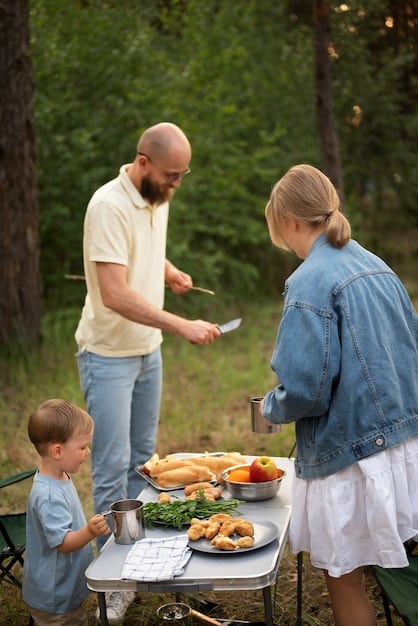
Estimating Travel Costs
Create a detailed budget that includes transportation, accommodation, park entrance fees, food, and activities. Factor in potential unexpected expenses.
Finding Affordable Accommodation
Consider camping or staying in budget-friendly hotels or motels outside park boundaries. Look for discounts and special offers.
- National Park Pass: Purchase an annual pass for unlimited access to over 2,000 federal recreation sites.
- Camping: Often the most affordable accommodation option.
- Meal Planning: Prepare your own meals to save on restaurant costs.
Strategic budgeting allows you to enjoy your National Park road trip: Planning the perfect itinerary for a cross-country adventure without breaking the bank.
Thoughtful planning and resourcefulness can significantly reduce expenses, making your adventure more accessible and sustainable.
Staying Safe and Healthy on the Road
Prioritizing safety and health is paramount on any road trip. This includes practicing safe driving habits, being prepared for emergencies, and maintaining a healthy lifestyle.
Practicing Safe Driving Habits
Drive defensively, avoid distractions, and take frequent breaks to prevent fatigue. Be aware of local traffic laws and weather conditions.
Preparing for Emergencies
Carry a well-stocked first-aid kit and know how to use it. Have a plan for dealing with vehicle breakdowns or medical emergencies.
- Emergency Contacts: Keep a list of important phone numbers.
- Roadside Assistance: Consider purchasing a roadside assistance plan.
- Health Insurance: Ensure you have adequate health insurance coverage.
By prioritizing safety and health, you can navigate your National Park road trip: Planning the perfect itinerary for a cross-country adventure with confidence and peace of mind.
Proactive measures to ensure your well-being contribute to a more enjoyable and secure travel experience.
| Key Point | Brief Description |
|---|---|
| 🗺️ Route Planning | Choose destinations, considering seasonal factors and interests. |
| 🎒 Essential Gear | Pack layers, navigation tools, and emergency supplies. |
| 💰 Budgeting | Estimate costs and find affordable accommodation. |
| 🏞️ Park Etiquette | Respect wildlife and follow Leave No Trace principles. |
Frequently Asked Questions
▼
The best time depends on the region. Spring and fall offer pleasant temperatures in many parks, while summer is ideal for high-elevation destinations. Winter can be challenging due to closures.
▼
Entrance fees vary by park, typically ranging from $20 to $35 per vehicle. An annual National Park Pass costs $80 and provides access to over 2,000 federal recreation sites.
▼
Essentials include comfortable hiking shoes, layers of clothing, sunscreen, insect repellent, a first-aid kit, a map or GPS device, and plenty of water. Consider packing camping gear if applicable.
▼
Many National Park campgrounds require advance reservations, especially during peak season. Booking well in advance is highly recommended, often several months ahead of your trip.
▼
Stay on marked trails, carry plenty of water and snacks, wear appropriate footwear, inform someone of your hiking plans, and be aware of wildlife. Check the weather forecast before heading out.
Conclusion
Embarking on a National Park road trip: Planning the perfect itinerary for a cross-country adventure is an enriching endeavor that requires thoughtful preparation and an adventurous spirit. By carefully considering your interests, mapping out your route, and prioritizing safety, you can create memories that will last a lifetime. Happy travels!
